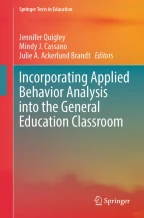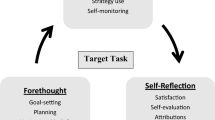Antecedent Interventions: Proactive Strategies for Changing Behavior

This chapter discusses a variety of proactive strategies for changing behavior that are applicable within the general education classroom setting. Antecedent variables (what happens prior to) can help predict behaviors and will be presented in the context of motivating operations (encourage or discourage a certain behavior). In addition, descriptions of antecedent interventions such as, behavior momentum, antecedent exercise, providing choices, visual schedules, foreshadowing, and countdowns are explained. Examples of how each one of these interventions can be applied will be provided.
This is a preview of subscription content, log in via an institution to check access.
Access this chapter
Subscribe and save
Springer+ Basic
€32.70 /Month
- Get 10 units per month
- Download Article/Chapter or eBook
- 1 Unit = 1 Article or 1 Chapter
- Cancel anytime
Buy Now
Price includes VAT (France)
eBook EUR 71.68 Price includes VAT (France)
Softcover Book EUR 89.66 Price includes VAT (France)
Tax calculation will be finalised at checkout
Purchases are for personal use only

Narrowing the Research to Practice Gap: A Primer to Self-Regulated Learning Application in School Psychology
Article 29 September 2020

Student Motivation: Current Theories, Constructs, and Interventions Within an Expectancy-Value Framework
Chapter © 2016
Theory of planned behavior in the classroom: An examination of the instructor confirmation-interaction model
Article 06 October 2017
References
- Amor, J. (2021). Cosmic kids yoga. www.cosmickids.com
- Baumeister, A. A., & MacLean, W. E., Jr. (1984). Deceleration of self-injurious and stereotypic responding by exercise. Applied Research in Mental Retardation,5(3), 385–393. https://doi.org/10.1016/s0270-3092(84)80059-4ArticlePubMedGoogle Scholar
- Brosh, Fisher, L. B., Wood, C. L., & Test, D. W. (2018). High-probability request sequence: an evidence-based practice for individuals with autism spectrum disorder. Education and Training in Autism and Developmental Disabilities, 53(3), 276–286 Google Scholar
- Cannella-Malone, H. I., Tullis, C. A., & Kazee, A. R. (2011). Using antecedent exercise to decrease challenging behavior in boys with developmental disabilities and an emotional disorder. Journal of Positive Behavior Interventions,13(4), 230–239. https://doi.org/10.1177/1098300711406122ArticleGoogle Scholar
- Carter, M., & Driscoll, C. (2007). A conceptual examination of setting events. Educational Psychology,27(5), 655–673. https://doi.org/10.1080/01443410701309183ArticleGoogle Scholar
- Cole, & Levinson, T. R. (2002). Effects of within-activity choices on the challenging behavior of children with severe developmental disabilities. Journal of Positive Behavior Interventions, 4(1), 29–37. https://doi.org/10.1177/109830070200400106
- Cooper, J. O., Heron, T. E., & Heward, W. L. (2007). Applied behavior analysis (2nd ed.). Pearson Education Inc. Google Scholar
- Davis, Brady, M. P., Hamilton, R., McEvoy, M. A., & Williams, R. E. (1994). Effects of high-probability requests on the social interactions of young children with severe disabilities. Journal of Applied Behavior Analysis, 27(4), 619–637. https://doi.org/10.1901/jaba.1994.27-619
- Dettmer, S., Simpson, R. L., Smith Myles, B., & Ganz, J. B. (2000). The use of visual supports to facilitate transitions of students with autism. Focus on Autism and Other Developmental Disabilities,15(3), 163–169. https://doi.org/10.1177/108835760001500307ArticleGoogle Scholar
- Dooley, P., Wilczenski, F. L., & Torem, C. (2001). Using an activity schedule to smooth school transitions. Journal of Positive Behavior Interventions,3(1), 57–61. https://doi.org/10.1177/109830070100300108ArticleGoogle Scholar
- Dunlap, G., DePerczel, M., Clarke, S., Wilson, D., Wright, S., White, R., & Gomez, A. (1994). Choice making to promote adaptive behavior for students with emotional and behavioral challenges. Journal of Applied Behavior Analysis,27(3), 505–518. https://doi.org/10.1901/jaba.1994.27-505ArticlePubMedPubMed CentralGoogle Scholar
- Folino, A., Ducharme, J. M., & Greenwald, N. (2014). Temporal effects of antecedent exercise on students’ disruptive behaviors: An exploratory study. Journal of School Psychology,52(5), 447–462. https://doi.org/10.1016/j.jsp.2014.07.002ArticlePubMedGoogle Scholar
- GoNoodle, Movement and Mindfulness for Kids. www.gonoodle.com
- Jeong, & Copeland, S. R. (2020). Comparing functional behavior assessment-based interventions and non-functional behavior assessment-based interventions: A systematic review of outcomes and methodological quality of studies. Journal of Behavioral Education, 29(1), 1–41. https://doi.org/10.1007/s10864-019-09355-4
- Kern, L., Koegel, R. L., & Dunlap, G. (1984). The influence of vigorous versus mild exercise on autistic stereotyped behaviors. Journal of Autism and Developmental Disorders,14(1), 57–67. https://doi.org/10.1007/BF02408555ArticlePubMedGoogle Scholar
- Kern, L., Koegel, R. L., Dyer, K., Blew, P. A., & Fenton, L. R. (1982). The effects of physical exercise on self-stimulation and appropriate responding in autistic children. Journal of Autism and Developmental Disorders,12(4), 399–419. https://doi.org/10.1007/BF01538327ArticlePubMedGoogle Scholar
- Mace, F. C., Hock, M. L., Lalli, J. S., West, B. J., Belfiore, P., Pinter, E., & Brown, D. K. (1988). Behavioral momentum in the treatment of noncompliance. Journal of Applied Behavior Analysis,21(2), 123–141. https://doi.org/10.1901/jaba.1988.21-123ArticlePubMedPubMed CentralGoogle Scholar
- McGimsey, J. F., & Favell, J. E. (1988). The effects of increased physical exercise on disruptive behavior in retarded persons. Journal of Autism and Developmental Disorders,18(2), 167–179. https://doi.org/10.1007/BF02211944ArticlePubMedGoogle Scholar
- Michael, J. (1982). Distinguishing between discriminative and motivational functions of stimuli. Journal of the Experimental Analysis of Behavior,42(1), 363–376. https://doi.org/10.1901/jeab.1982.37-149ArticleGoogle Scholar
- Morrison, H., Roscoe, E. M., & Atwell, A. (2011). An evaluation of antecedent exercise on behavior maintained by automatic reinforcement using a three-component multiple schedule. Journal of Applied Behavior Analysis,44(3), 523–541. https://doi.org/10.1901/jaba.2011.44-523ArticlePubMedPubMed CentralGoogle Scholar
- Pierce, J. M., Spriggs, A. D., Gast, D. L., & Luscre, D. (2013). Effects of visual activity schedules on independent classroom transitions for students with autism. International Journal of Disability, Development and Education,60, 253–269. https://doi.org/10.1080/1034912X.2013.812191ArticleGoogle Scholar
- Puddicombe, A. (2022). Headspace.www.headspace.com
- Riviere, V., Becquet, M., Peltret, E., Facon, B., & Darcheville, JC. (2011). Increasing compliance with medical examination requests directed to children with autism: Effects of a high-probability request procedure. Journal of Applied Behavior Analysis, 44(1), 193–197. https://doi.org/10.1901/jaba.2011.44-193
- Smith, M. A., & Tew, A. (2022). Calm.www.calm.com
Author information
Authors and Affiliations
- The Chicago School of Professional Psychology, Chicago, IL, USA Mindy J. Cassano, Holly Bruski & Sarah Bendekovits
- Mindy J. Cassano


